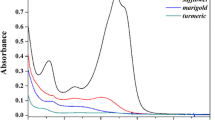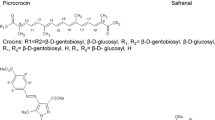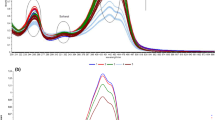Abstract
Saffron quality is commonly determined by three parameters: color, aroma, and taste. Several factors including harvesting and post-harvesting conditions, affect these parameters. In this study, the effect of storage time on saffron quality was evaluated. At first, the relative concentration of the saffron secondary metabolites in freshly dried and 2 years stored saffron samples prepared with ISO 3632 and UA-DLLME methods and then measured using UV–Vis and GC-FID techniques. In order to find saffron storage time biomarkers, the obtained data were subjected to several data analysis steps including data preprocessing, principal component analysis (PCA), partial least square discriminant analysis (PLS-DA) and variable selection methods. Based on the obtained main biomarkers and proposed molecule mechanism, it can be concluded that during the storage periods, the intensity of saffron color reduces, while its aroma increases, reflecting a negative correlation between them. Freshly dried samples have a higher level of the crocins as coloring agents, β-isophorone, 4-hydroxy-3,5,5-trimethylcyclohex-2-enone and picrocrocin, while the stored samples were more abundant by safranal as the main saffron aroma agent.




Similar content being viewed by others
References
Abdullaev FI (2004) Antitumor effect of saffron (Crocus sativus L.): overview and perspectives. Acta Hortic 650:491–499
Acar B, Sadikoglu H, Doymaz I (2015) Freeze-drying kinetics and diffusion modeling of saffron (Crocus sativus L.). J Food Process Preserv 39:142–149
Alavizadeh SH, Hosseinzadeh H (2014) Bioactivity assessment and toxicity of crocin: a comprehensive review. Food Chem Toxicol 64:65–80
Aliakbarzadeh G, Sereshti H, Parastar H (2016) Pattern recognition analysis of chromatographic fingerprints of Crocus sativus L. secondary metabolites towards source identification and quality control. Anal Bioanal Chem 408:3295–3307
Andersen CM, Bro R (2010) Variable selection in regression—a tutorial. J Chemom 24:728–737
Ballabio D (2015) A MATLAB toolbox for principal component analysis and unsupervised exploration of data structure. Chemom Intell Lab Syst 149:1–9
Ballabio D, Consonni V (2013) Classification tools in chemistry. Part 1: linear models. PLS-DA. Anal Methods 5:3790–3798
Bononi M, Milella P, Tateo F (2015) Gas chromatography of safranal as preferable method for the commercial grading of saffron (Crocus sativus L.). Food Chem 176:17–21
Carmona M, Zalacain A, Salinas MR, Alonso GL (2006) Generation of saffron volatiles by thermal carotenoid degradation. J Agric Food Chem 54:6825–6834
Carta A, Campigli S, Peruzzi L, Bedini G (2016) The avoidance of self-interference in the Tuscan endemic spring geophyte Crocus etruscus Parl. (Iridaceae). Plant Biosyst 150:1358–1363
De La Mata-Espinosa P, Bosque-Sendra JM, Bro R, Cuadros-Rodríguez L (2011) Discriminating olive and non-olive oils using HPLC-CAD and chemometrics. Anal Bioanal Chem 399:2083–2092
Frusciante S, Diretto G, Bruno M, Ferrante P, Pietrella M, Prado-Cabrero A, Giuliano G (2014) Novel carotenoid cleavage dioxygenase catalyzes the first dedicated step in saffron crocin biosynthesis. Proc Natl Acad Sci USA 111:12246–12251
ISO 3632–2 Technical Specification (2014) Saffron (Crocus sativus L.), Part 2 (test methods). International Organization for Standardization, Geneva, Switzerland
Liland KH (2011) Multivariate methods in metabolomics from pre-processing to dimension reduction and statistical analysis. Trends Anal Chem 30:827–841
Maggi L, Carmona M, Zalacain A, Kanakis CD, Anastasaki E, Tarantilis PA, Alonso GL (2010) Changes in saffron volatile profile according to its storage time. Food Res Int 43:1329–1334
Melnyk JP, Wang S, Marcone MF (2010) Chemical and biological properties of the world’s most expensive spice: saffron. Food Res Int 43:1981–1989
Ordoudi SA, Tsimidou MZ (2004) Saffron quality: effect of agricultural practices, processing and storage. In: Dris R, Jain SM (eds) Production practices and quality assessment of food crops, vol 1. Springer, Dordrecht, pp 209–260
Peruzzi L (2016) Crocus heuffelianus (Iridaceae), a new record for the Italian flora. Phytotaxa 261:291–294
Raina BL, Agarwal SG, Bhatia AK, Gaur GS (1996) Changes in pigments and volatiles of saffron (Crocus sativus L.) during processing and storage. J Sci Food Agric 71:27–32
Rashed-Mohassel MH (2007) Saffron from wild to the field. Acta Hortic 739:187–193
Reza Gohari A, Saeidnia S, Kourepaz Mahmoodabadi M (2013) An overview on saffron, phytochemicals, and medicinal properties. Pharmacogn Rev 7:61–66
Rinnan Å, Andersson M, Ridder C, Engelsen SB (2014) Recursive weighted partial least squares (rPLS): an efficient variable selection method using PLS. J Chemom 28:439–447
Sánchez AM, Carmona M, Prodanov M, Alonso GL (2008) Effect of centrifugal ultrafiltration on the composition of aqueous extracts of saffron spice (Crocus sativus L.). J Agric Food Chem 56:7293–7301
Sereshti H, Heidari R, Samadi S (2014) Determination of volatile components of saffron by optimised ultrasound-assisted extraction in tandem with dispersive liquid–liquid microextraction followed by gas chromatography–mass spectrometry. Food Chem 143:499–505
Vallejo M, Angulo S, García-Martínez D, García A, Barbas C (2008) New perspective of diabetes response to an antioxidant treatment through metabolic fingerprinting of urine by capillary electrophoresis. J Chromatogr A 1187:267–274
Author information
Authors and Affiliations
Corresponding author
Electronic supplementary material
Below is the link to the electronic supplementary material.
Rights and permissions
About this article
Cite this article
Sereshti, H., Ataolahi, S., Aliakbarzadeh, G. et al. Evaluation of storage time effect on saffron chemical profile using gas chromatography and spectrophotometry techniques coupled with chemometrics. J Food Sci Technol 55, 1350–1359 (2018). https://doi.org/10.1007/s13197-018-3046-9
Revised:
Accepted:
Published:
Issue Date:
DOI: https://doi.org/10.1007/s13197-018-3046-9




